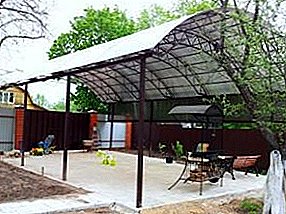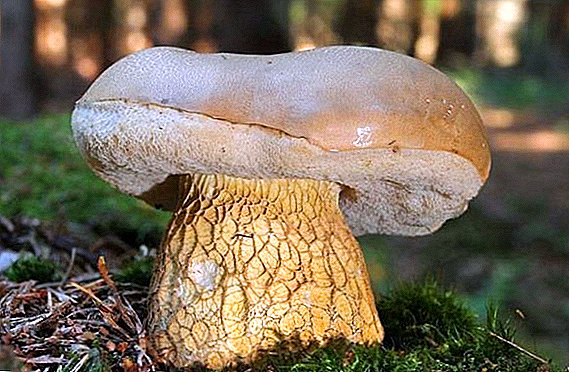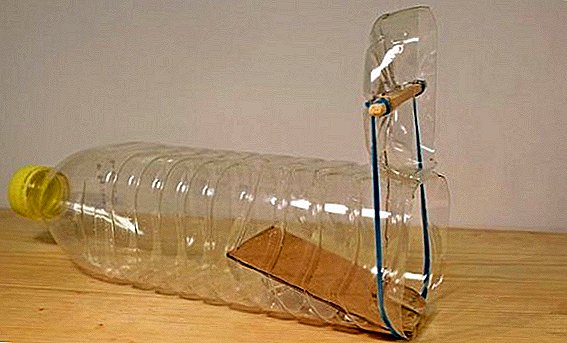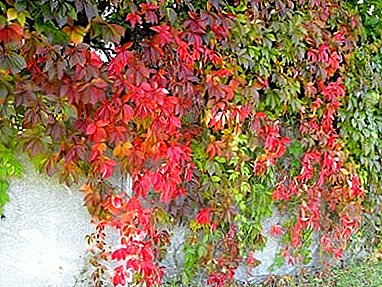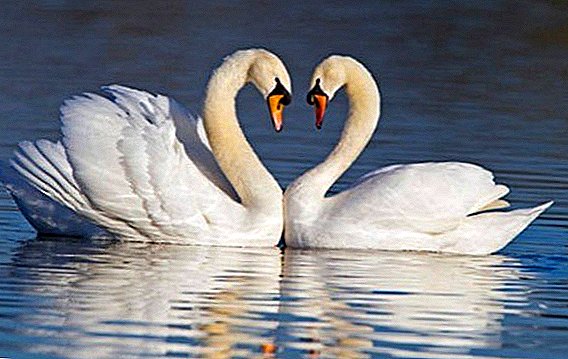 The majestic and graceful birds - mute swans, are often found in city parks with large ponds or lakes and invariably delight and admire all those who observe. At the same time, few people know about the peculiarities of life, nutrition and behavior of this species of swans: we offer to get to know them better.
The majestic and graceful birds - mute swans, are often found in city parks with large ponds or lakes and invariably delight and admire all those who observe. At the same time, few people know about the peculiarities of life, nutrition and behavior of this species of swans: we offer to get to know them better.
Description and Features
Mute swans have a very expressive, spectacular appearance, which is only emphasized by the large size of the birds. They got their name due to the fact that the male makes a specific pinching soundif he or the pack is in danger. However, in addition to hissing, they are capable of producing sounds similar to grunting, whistling, snorting. Outwardly, the spike from other species of swans can be distinguished by a gracefully curved massive neck, an orange beak, constantly raised wings and a black cone at the base of the beak.
Did you know? Mute swans are the largest and heaviest flying birds on the planet.
Appearance
The main external characteristics of the bird:
- head - medium size, covered with a short white feathers, there is a black border around the eyes and beak;
- eyes - small, black, planted on the sides of the head;
- beak - long, red-orange color with black markings near the nostrils, on the tip and at the base; near the forehead is a black growth (bridle), which in males tends to increase in the mating season;
- neck - very long and thick, flexible;
- body - oblong, massive, with wide sternum;
- wings - powerful, muscular, long and wide, cover a significant part of the back and sides;
- tail - short, when flying opens like a fan, on the water it gathers into a narrow, pointed beam;
- legs - short, powerful;
- feathering - dense, with thick down, in adults, snow-white.









It is noteworthy that the little swans are not at all like their parents: they are plain and very unpresentable. The color of their legs, feathers and beak is gray. Only after reaching the age of 2-3 years will they become adults, sexually mature and similar in appearance to their parents.
Dimensions and life expectancy
The main parameters of mute swans:
- male weight - 10-15 kg;
- female weight - 8-10 kg;
- body length - 150-160 cm;
- wingspan - 200-240 cm;
- life expectancy is 25-28 years in the wild, 30 years in captivity (however, birds often live around 7-10 years).
Did you know? These birds are not only large, but also very strong. - the blow of a mute swan can kill a small beast (for example, a fox or a dog) or break a man's hand!
Habitat and habitat
This feathered has a relatively large range: they live throughout Europe and Central Asia. Thanks to the efforts of a man, a spike can now be found in the south of the African continent, in Australia and New Zealand, in North America. It is noteworthy that in Europe most of the swans are tamed or live in semi-novole: they are bred as decorative birds for parks, while populations of wild birds dominate in Asia.  Mute swan settles in territories up to 500 m above sea level. Usually they choose sea bays, estuaries, estuaries and fresh water in the city. Nest also on the Atlantic coast, the shores of the Baltic Sea, the Asian coasts. After breeding, offspring migrate to winter to the Black and Caspian Seas. Some birds stay for the winter in nesting places where they are fed by people. In such cases, they can be combined into small colonies.
Mute swan settles in territories up to 500 m above sea level. Usually they choose sea bays, estuaries, estuaries and fresh water in the city. Nest also on the Atlantic coast, the shores of the Baltic Sea, the Asian coasts. After breeding, offspring migrate to winter to the Black and Caspian Seas. Some birds stay for the winter in nesting places where they are fed by people. In such cases, they can be combined into small colonies.
Read also about breeding swans at home, as well as breeding and feeding wild ducks.
Lifestyle and behavior
Birds are distinguished for their peace-loving, friendly and calm disposition. They favorably relate to other animals and birds, and cases of aggression are possible only when defending their territory. When a danger arises, the male spreads its wings widely, bristling feathers on its back, arching its neck and swimming towards the uninvited guest. During the fight, the swans forcefully strike each other with their wings and beaks. That is why it is not recommended to show excessive interest, finding the nest of swans, as the male can cause serious injury, defending the clutch.  Much of the time, the spike swans devote to cleaning the plumage of parasites and pollution, as well as lubricating it with the secretion of the oil gland. After the flight to the nesting site, they begin to molt, in which birds lose all their primary feathers and ability to fly. It is interesting that at first the female begins to molt, since at this time she incubates the eggs and cannot leave. After her plumage is replaced, the molt begins at the male: it lasts about 5-6 weeks.
Much of the time, the spike swans devote to cleaning the plumage of parasites and pollution, as well as lubricating it with the secretion of the oil gland. After the flight to the nesting site, they begin to molt, in which birds lose all their primary feathers and ability to fly. It is interesting that at first the female begins to molt, since at this time she incubates the eggs and cannot leave. After her plumage is replaced, the molt begins at the male: it lasts about 5-6 weeks.  Despite the large size and considerable weight, the mute swans are excellent flyers. During migration, they are united in related groups, and then in many thousands of colonies, thus reducing the risk of predator attacks. Fly a beautiful slender key at a small height. If adverse weather conditions do not allow the bird to fly, the swans fall to the ground, hide their beaks and paws under the feathering and patiently wait for the weather to improve.
Despite the large size and considerable weight, the mute swans are excellent flyers. During migration, they are united in related groups, and then in many thousands of colonies, thus reducing the risk of predator attacks. Fly a beautiful slender key at a small height. If adverse weather conditions do not allow the bird to fly, the swans fall to the ground, hide their beaks and paws under the feathering and patiently wait for the weather to improve.
Learn more about the different types of swans, in particular, the black swan.
What to eat
The basis of the diet of mute swans is vegetable food. Birds are in search of food throughout the day - a large adult individual can eat up to 4 kg of food per day.  Due to the long flexible neck, birds can extract vegetation from the bottom in shallow water that other birds are not able to reach. When diving they dive to a depth of 1 m, while from the water you can see only the tail and legs. Underwater spines can be up to 10 seconds, all the time they eat. On land, birds use herbs, cereals, and fodder crops. From animal food, they are not averse to eat toads, small fish, insects, clams.
Due to the long flexible neck, birds can extract vegetation from the bottom in shallow water that other birds are not able to reach. When diving they dive to a depth of 1 m, while from the water you can see only the tail and legs. Underwater spines can be up to 10 seconds, all the time they eat. On land, birds use herbs, cereals, and fodder crops. From animal food, they are not averse to eat toads, small fish, insects, clams.
Important! Swans (as well as other waterfowl) in any case can not be fed any bakery products! Such food can lead to the death of birds. If you want to help winders, feed them grain mixture.
Procreation
Mute swans are monogamous birds and make a couple for life. This usually occurs at the age of 3-4 years. If one of the pair dies, the second after a while creates a new pair. For nesting, swans occupy a territory that the male carefully protects from competitors and enemies.
Main features:
- sexual maturity, 2-3 years;
- the beginning of nesting is March;
- the number of eggs - 5-9;
- incubation - 34-38 days;
- feeding and caring for chicks - 4-5 months.
Mating season begins in early spring for those birds that have not yet found a partner. To obtain the location of the female, the male swims around her with raised wings, puffed feathers around his neck, twisting his head from side to side. If the female takes care of her, she becomes in a similar position. Pairing usually occurs in water.  After that, the birds start nest arrangement: it is usually very large in size, may be located on the water in the form of a floating platform or in a reed. Sedge, cattail, reed and algae sprigs serve as building materials. Usually, they are harvested by the male, while the female is engaged directly in construction, connecting the stalks into clumps of mud. The result is a nest with a diameter of up to 150 cm and a height of up to 60 cm. At the top, the female makes a depression (10-15 cm), lines it with soft plants and down.
After that, the birds start nest arrangement: it is usually very large in size, may be located on the water in the form of a floating platform or in a reed. Sedge, cattail, reed and algae sprigs serve as building materials. Usually, they are harvested by the male, while the female is engaged directly in construction, connecting the stalks into clumps of mud. The result is a nest with a diameter of up to 150 cm and a height of up to 60 cm. At the top, the female makes a depression (10-15 cm), lines it with soft plants and down.  When the nest is ready, the female starts laying eggs in a day, then proceeds to incubating. She can only leave for feeding, at this time the eggs warm the male. When hatched, the head of the family carefully guards the female and the clutch, and both parents take care of the offspring.
When the nest is ready, the female starts laying eggs in a day, then proceeds to incubating. She can only leave for feeding, at this time the eggs warm the male. When hatched, the head of the family carefully guards the female and the clutch, and both parents take care of the offspring.  Just hatched chicks able to immediately leave the nest and eat what they find themselves. Shortly after hatching, they descend into the water, returning to the parents' nest for the night. Sometimes small chicks climb up to the adult under the wing and thus move through the water. Chicks grow up and mature slowly, with their parents they stay up to a year. Starting from 3 months, the swans are already able to fly.
Just hatched chicks able to immediately leave the nest and eat what they find themselves. Shortly after hatching, they descend into the water, returning to the parents' nest for the night. Sometimes small chicks climb up to the adult under the wing and thus move through the water. Chicks grow up and mature slowly, with their parents they stay up to a year. Starting from 3 months, the swans are already able to fly.
It is interesting to read about unusual birds: wild chickens, pheasants (white, royal, golden, long-eared), Himalayan monal, peacock, nandu, emu, ostrich, crowned pigeon, mandarin duck.
Size and conservation status
At the turn of the XIX-XX centuries throughout the whole of Europe, the Mute Swan was actively hunted, therefore their number sharply decreased. In 1960, hunting for birds was banned, due to which their numbers began to grow, and at the moment there is no threat of extinction. To date, the number of these birds reaches 500 thousand individuals. Previously, the mute swan was listed in the Red Book of the Republic of Belarus (currently excluded), the Republic of Bashkortostan and some regions of the Russian Federation. On the territory of Russia to hunt for mute swans is prohibited.
Important! Lead weights of fishing equipment, high-voltage lines, poachers are a great danger for the species. They are also adversely affected by pollution of water bodies, building and industrial use of places suitable for the breeding of spike.
Video: Mute Swans
The beautiful and majestic birds we have considered require careful and attentive attitude. Now often, the spines are domesticated completely and are kept as a decorative bird on private farmsteads with access to the reservoir. The bird calmly treats people without showing fear or aggression - that is why the spines have become such frequent inhabitants of urban ponds.


